MARIANI’SVirtual
Gourmet
September
11,
2011
NEWSLETTER
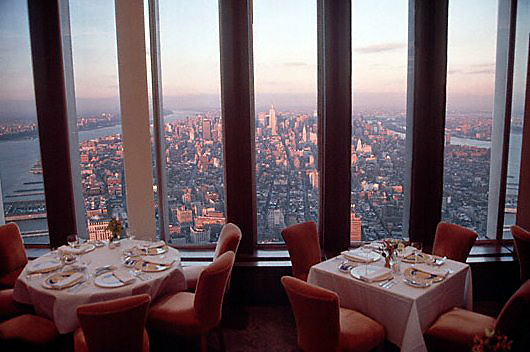
Windows on the World, North Tower of the World Trade Center
Very Important Announcement!
 |
My latest book, written with Jim Heimann and Steven Heller, Menu Design in America, 1850-1985 (Taschen Books), has just appeared, with nearly 1,000 beautiful, historic, hilarious, sometimes shocking menus dating back to before the Civil War and going through the Gilded Age, the Jazz Age, the Depression, the nightclub era of the 1930s and 1940s, the Space Age era, and the age when menus were a form of advertising in innovative explosions of color and modern design. The book is a chronicle of changing tastes and mores and says as much about America as about its food and drink.
“Luxuriating vicariously in the pleasures of this book. . . you can’t help but become hungry. . .for the food of course, but also for something more: the bygone days of our country’s splendidly rich and complex past. Epicureans of both good food and artful design will do well to make it their cofee table’s main course.”—Chip Kidd, Wall Street Journal.
“[The menus] reflect the amazing craftsmanship that many restaurants applied to their bills of fare, and suggest that today’s restaurateurs could learn a lot from their predecessors.”—Rebecca Marx, The Village Voice.
“Restaurateurs, take note: A resurgence in thoughtful, artistic menus is past due.”—Bon Appetit Magazine |
by John Mariani
CHARLESTON CHOW
by John Mariani
NEW YORK CORNER: MORNINGSIDE HEIGHTS BY DAY AND NIGHT
by Francesca Crozier-Fitzgerald
MAN ABOUT TOWN: GRAND VELAS, RIVIERA MAYA
by Christopher Mariani
GOOD NEWS! Esquire.com has a new food section called "Eat Like a Man," which will be featuring
restaurant articles by John Mariani and others from around the USA.
This Week: The Secret Past of Your Favorite Foods.
and
Where'd These Drinks Come From?
❖❖❖
WHY WE DINE
by John Mariani
On the day the day
the World Trade Center was destroyed, Sirio Maccioni, owner of New
York’s Le Cirque 2000, called then Mayor Rudy Giuliani to ask how
he might help in the crisis. Giuliani said two words: “Stay
open.”
That night Le Cirque did only 65 covers. Two weeks later, on a
Saturday
night, the restaurant served 260.
That sentiment has
always carried weight with me, not only because sitting down to a meal
requires
the harried mind to re-focus attention on a basic human ritual
but
because it truly helps to return to a normal need. After hearing
of a
tragedy, the appetite may flag, eating may be the last thing on one’s
mind, and
dining seems downright frivolous. But to restore one’s appetite
is to
restore one’s strength, as anyone who has long been sick knows.
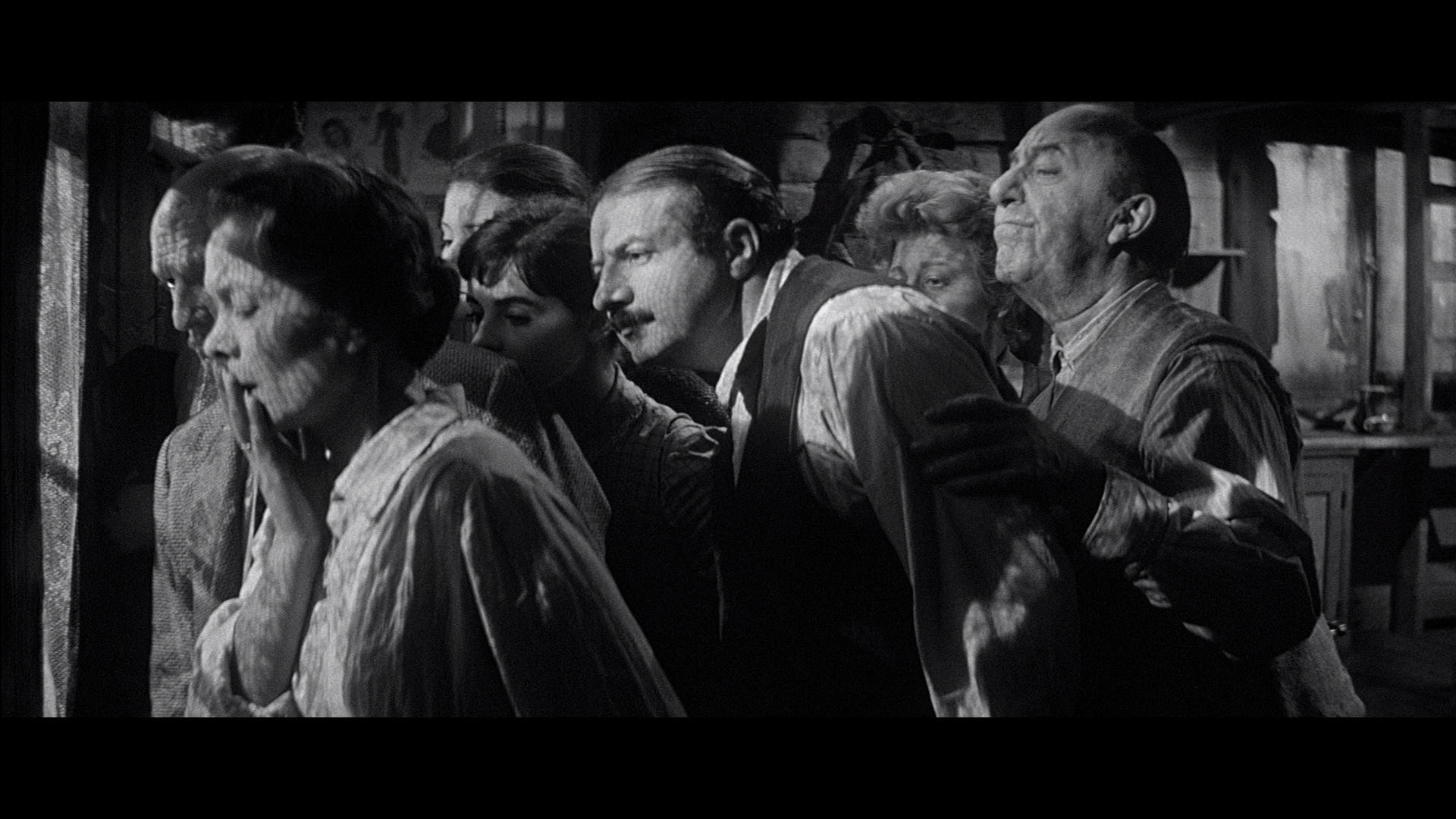 That same year, when I
heard the news that my mother had passed away overnight, I was tying my
tie in
a room at the Crillon Hotel in Paris, ready to go down to dinner. The
news had
the obvious effect of bringing me to my knees, but after commiserating
with my
wife, I determined that going down to dinner would be the very best
thing,
rather than stay in the room and weep. We went to dinner, sure
that my
mother, who gave me life, nurtured me as an infant, and imbued me with
a love
of good food, a woman who was a great hostess and loved nothing more
than going
out to a fine restaurant, would have insisted I do so. And so, we
ate
very well and drank a very fine wine, toasting my mother as she so
richly
deserved.
That same year, when I
heard the news that my mother had passed away overnight, I was tying my
tie in
a room at the Crillon Hotel in Paris, ready to go down to dinner. The
news had
the obvious effect of bringing me to my knees, but after commiserating
with my
wife, I determined that going down to dinner would be the very best
thing,
rather than stay in the room and weep. We went to dinner, sure
that my
mother, who gave me life, nurtured me as an infant, and imbued me with
a love
of good food, a woman who was a great hostess and loved nothing more
than going
out to a fine restaurant, would have insisted I do so. And so, we
ate
very well and drank a very fine wine, toasting my mother as she so
richly
deserved.
As a food and
travel writer what I do for a living may seem odd (T.S. Eliot wrote,
“We
measure out our lives in coffee spoons,” but I measure out mine
in
morsels of foie gras), but, whenever I think of it as ephemeral to the
great
issues of the day, I am reminded of a scene in the movie based on The Diary of Anne Frank (left) in which
the
family, isolated for months in an attic but still believing they will
soon be
out, fantasize about the first thing they’ll do when they return to the
world
outside. Anne says she yearns to go to a dance. The teenage boy
wants to
go to a movie, a western movie! And the adults all start remembering
and
dreaming of a wonderful pastry shop, a good stew, a romantic restaurant
with
thick linen and fine wines. None, not one, declares that the
first thing
he wants to do is to change the political structure of Europe.
This scene made me
realize not only that deprivation takes away freedoms of movement but
also
access to the most wonderful sights, sounds, and tastes of life--the
very things
we live for until they are taken away from us. 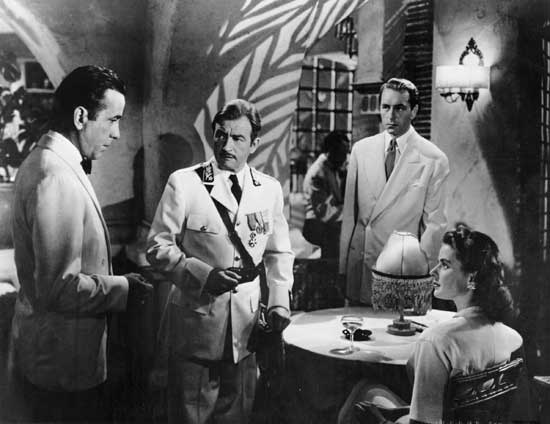 Every
human being on earth who
has ever gone hungry thinks first of survival, then of doing something
seemingly superficial--a dance, a western movie, a visit to a
restaurant.
For when all goes well, when the doctor cuts out the cancer, when debt
is
retired, when the debris is cleared away, returning to normal means
returning
to those things that make life worth living.
Every
human being on earth who
has ever gone hungry thinks first of survival, then of doing something
seemingly superficial--a dance, a western movie, a visit to a
restaurant.
For when all goes well, when the doctor cuts out the cancer, when debt
is
retired, when the debris is cleared away, returning to normal means
returning
to those things that make life worth living.
During
World War II director Frank Capra made a series of powerful propaganda
films
entitled “Why We Fight,” and if seeing yet again the cheesecake photos
(an
interesting turn of phrase) of Rita Hayworth and Betty Grable in
servicemen’s
lockers seems pointedly nostalgic, that does not destroy its touching
allure. “Why We Dine” is as reasonable a proposition as any
other, once
we survive the inevitable rigors and horrors of life that must be
endured. It is not by accident that the setting for the film
"Casablanca" was in a place that seemed a neutral oasis in Vichy,
where the horrors of war cannot intrude, but in fact Rick's Café
Americaine was a whirlwind of political and moral dilemmas.
So I carry on
extolling and criticizing our world’s food culture, sometimes
whimsically,
sometimes with vitriol. For the importance of dining out, and
drinking
good wine, and falling in love under the spell of candlelight at the
dinner
table is to enjoy all that terrorists--especially those whose religious
fanaticism seeks to deprive people of all pleasure--would seek to
destroy. By indulging in life’s passions we do much more than
live out
our lives. We gain strength in the belief that they are part of
the
goodness of man.
Eat well,
be well.
"Catfish" by Charleston artist William McCullough
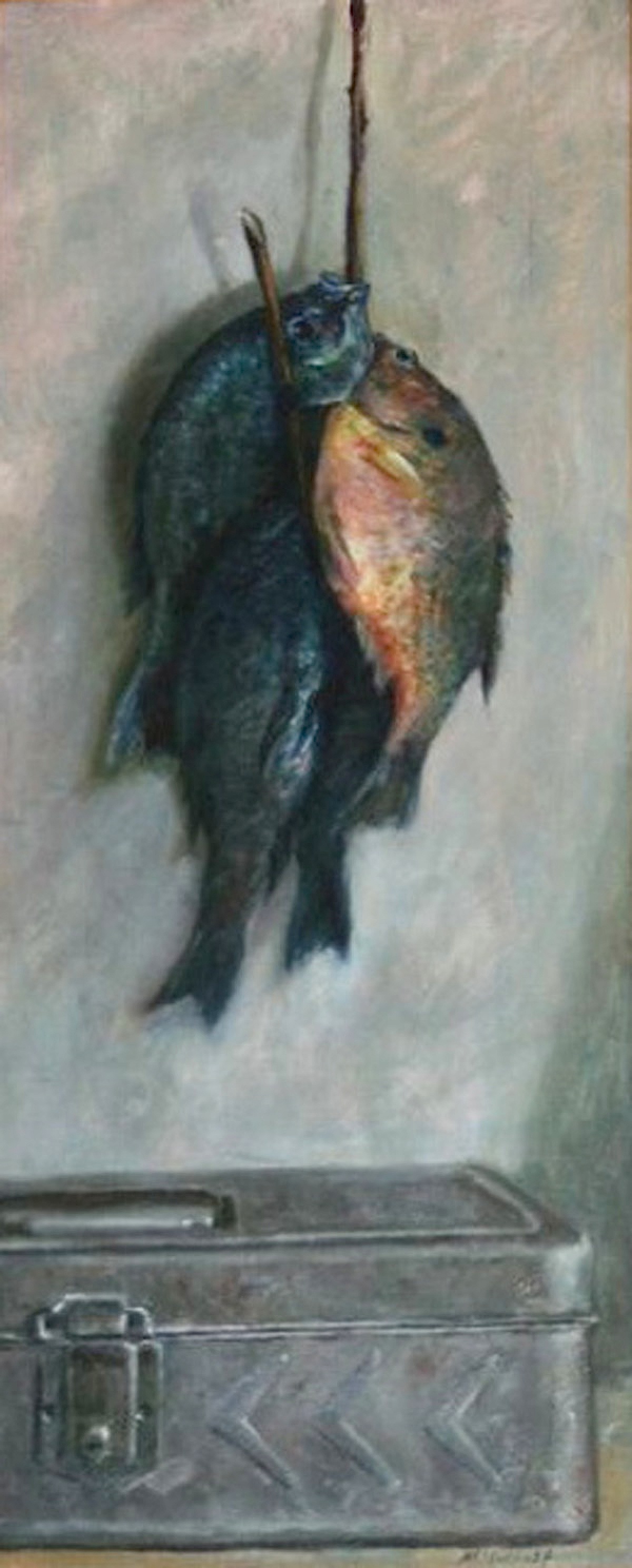 I've been
going to and writing about Charleston, SC, pretty much on an
annual basis
for some time now, not least because I love attending the Charleston
Food
&
Wine
Festival
held each spring, when Charleston is abloom
and the whole town turns out for always overbooked activities, lunches,
and dinners through the weekend. It also gives me a chance to
catch up on what's new and how established places are doing.
I've been
going to and writing about Charleston, SC, pretty much on an
annual basis
for some time now, not least because I love attending the Charleston
Food
&
Wine
Festival
held each spring, when Charleston is abloom
and the whole town turns out for always overbooked activities, lunches,
and dinners through the weekend. It also gives me a chance to
catch up on what's new and how established places are doing.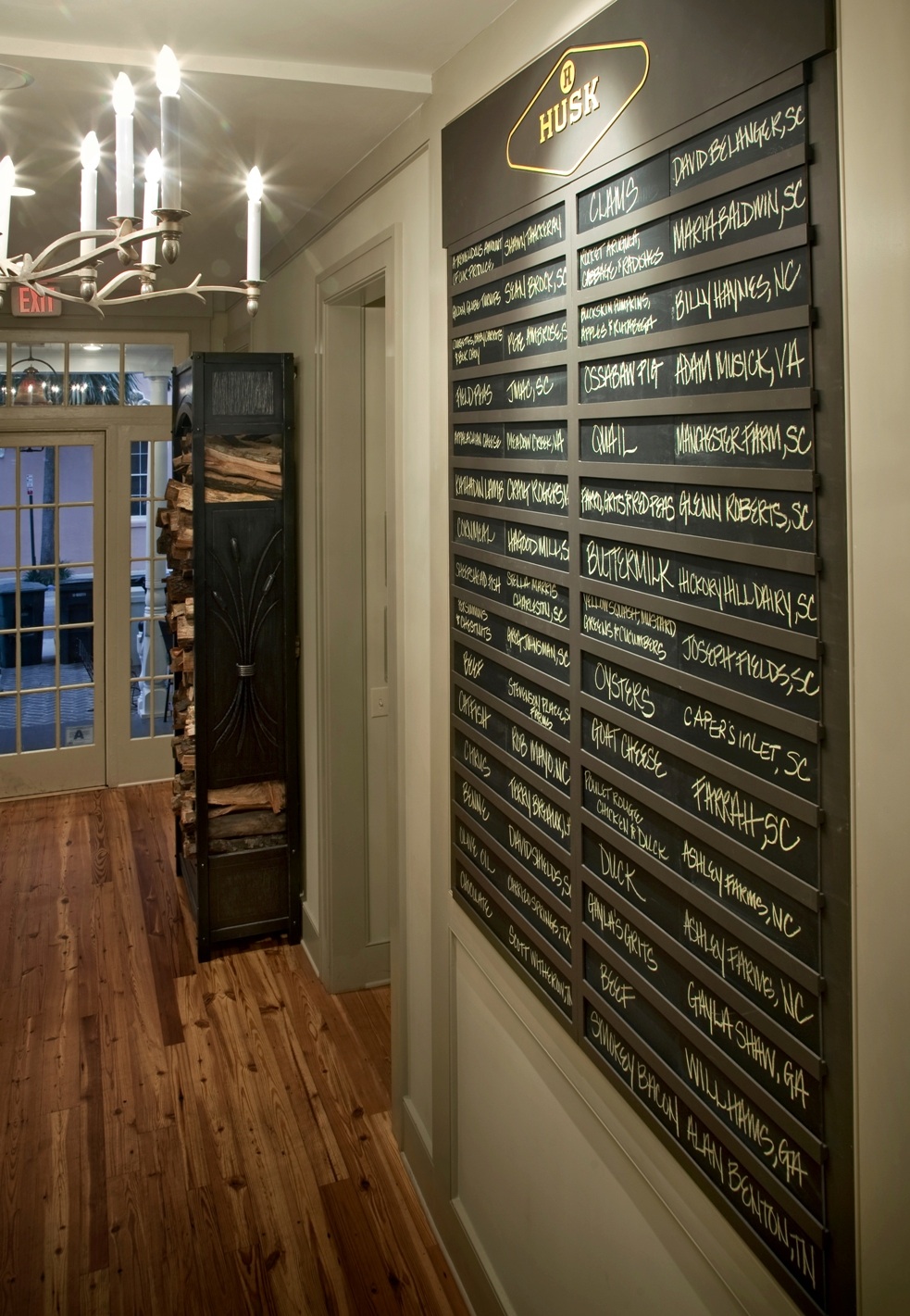 from
the South, it’s not coming through the door,' says
Brock, who has even stricken olive oil from the kitchen. As he
explains, the resulting cuisine `is not about rediscovering Southern
cooking, but exploring the reality of Southern food.'
Seed-saving, heirloom husbandry, and in-house pickling and
charcuterie efforts by the culinary team are the basis of the cuisine
at Husk. The restaurant is as casual as it is chic, evoking a way of
life centered on seasonality and the grand traditions of Charleston
life—one lived at a slower pace, preferably with a cocktail and a wide
porch in the late afternoon."
from
the South, it’s not coming through the door,' says
Brock, who has even stricken olive oil from the kitchen. As he
explains, the resulting cuisine `is not about rediscovering Southern
cooking, but exploring the reality of Southern food.'
Seed-saving, heirloom husbandry, and in-house pickling and
charcuterie efforts by the culinary team are the basis of the cuisine
at Husk. The restaurant is as casual as it is chic, evoking a way of
life centered on seasonality and the grand traditions of Charleston
life—one lived at a slower pace, preferably with a cocktail and a wide
porch in the late afternoon."All of which I find admirable--even to their making their own salt on the roof!--if a tad doctrinaire. Fortunately this doctrine does not carry through to wine and spirits, so if you want a vodka Martini or a Spanish wine, you can get it. Otherwise you'd be drinking wines pretty much exclusively from Virginia and Maryland.
Anyway, it's a fine old structure, resembling someone's Charleston rooming house, with two floors. The prices on the dinner menu are very reasonable, nothing more than $26. Needless to say, Southern hospitality rules here.
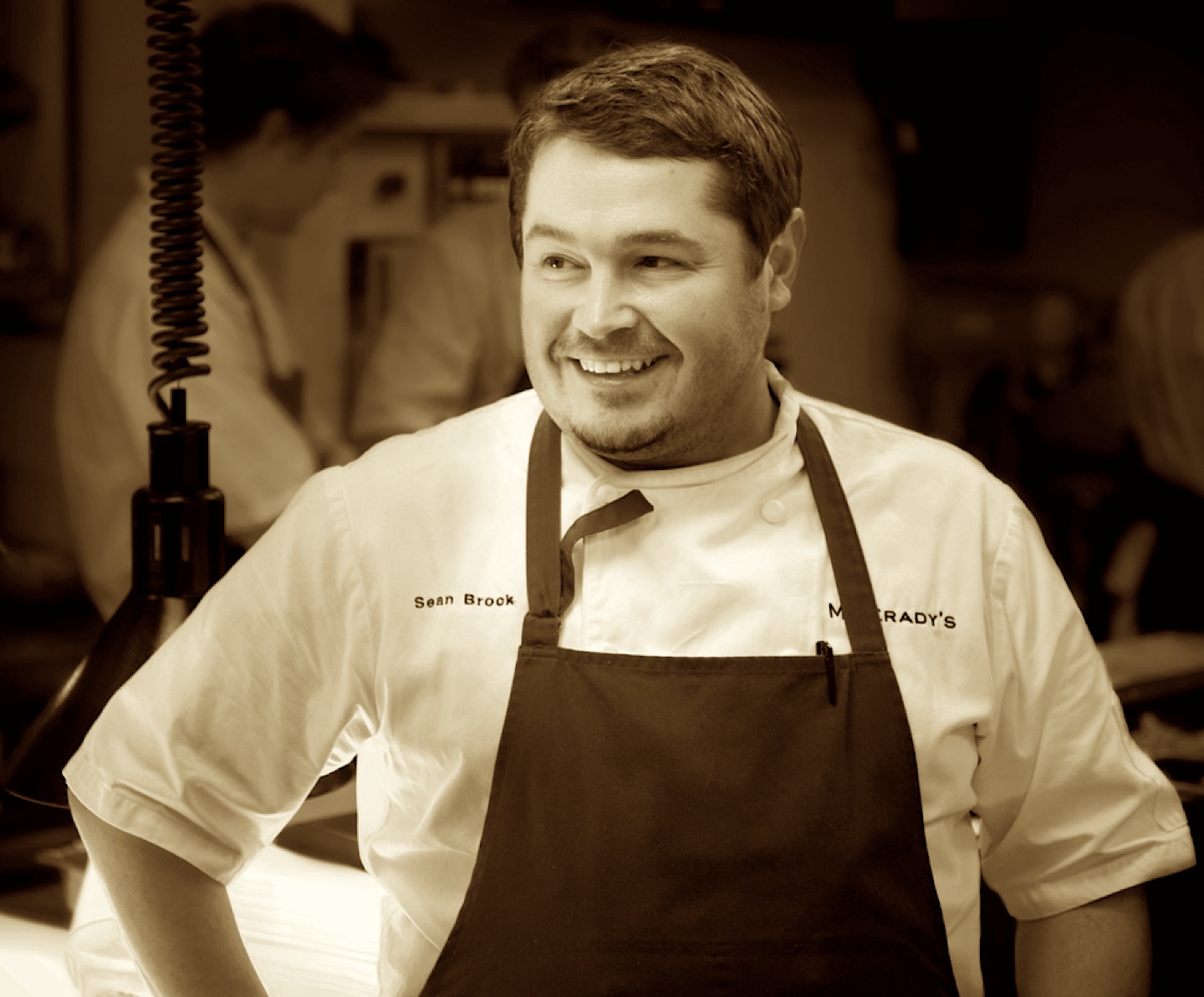 The menu changes all the time, but I stated
off with deviled eggs, crispy rillettes, a foie gras parfait (is foie
gras indigenous to the South?), and fried chicken skins. One of
the best appetizers was South Carolina quail, nice and meaty, stuffed
with cornbread and country sausage, peas, and pickled peaches.
Wood-fired clams with braised peppers and sausage topped crispy bread,
while a true country stew of rabbit with dumplings is indicative of
what Husk is all about. There's also a platter of various
Southern hams, and that is an
education.
The menu changes all the time, but I stated
off with deviled eggs, crispy rillettes, a foie gras parfait (is foie
gras indigenous to the South?), and fried chicken skins. One of
the best appetizers was South Carolina quail, nice and meaty, stuffed
with cornbread and country sausage, peas, and pickled peaches.
Wood-fired clams with braised peppers and sausage topped crispy bread,
while a true country stew of rabbit with dumplings is indicative of
what Husk is all about. There's also a platter of various
Southern hams, and that is an
education. The South has always made great desserts, and Brock (above) knows that, so they'd better be special, and are: S'mores bread pudding (have it with a glass of bourbon on the side), and pecan pie with chocolate and herbsaint cream. Of course, there's a decadent black bottom pie in a jar, with bourbon vanilla cream.
Brock's menus at McCrady's may be more elegantly presented--and it's one of the best in the city--but his heart and soul are in Husk, and you'll taste it in every dish.
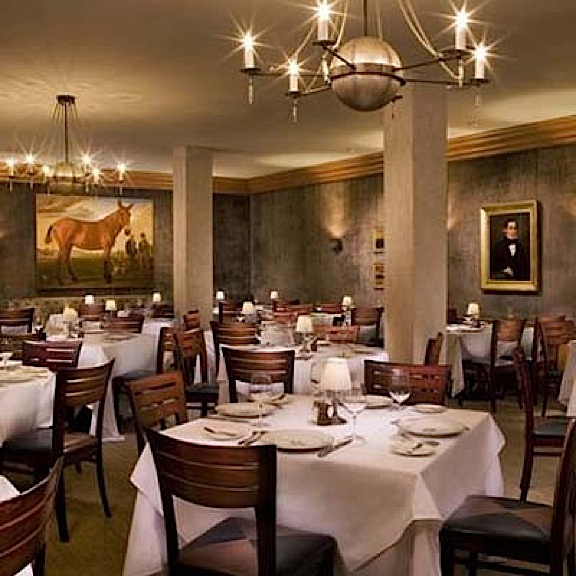
I've dined many time over the years here, since Carter took over in 1997--often staying at the adjacent Planters Inn--and while consistency is one of Carter's hallmarks and his own commitment to Low Country ingredients is unassailable, there is always innovation on the menu, like the lobster 3-way ravioli with a warm tomato basil vinaigrette. You can stay very simple with platters of oysters or crabmeat, but Carter will combine them in wonderful ways the lobster and crab cake duo with Creole mustard vinaigrette. Foie gras takes on Southern BBQ sauce with ease, on the side a black pepper biscuit and peach jam. There's a rich chilled asparagus and sweet Vidalia onion soup with a smoked trout relish, and lobster and corn chowder--but there is a sampling of three soups (a mere $12) that is clearly the way to go.
For a salad very much in the Southern style, have the "Super-Chilled" wedge of iceberg lettuce with smoked bacon jerky and buttermilk dressing. Then there are the unadorned, first-rate steaks and chops, all with various sauce options, but I seem always to go for the seasonal specialties like grilled shrimp with hoppin' John, green onion-horseradish hushpuppies and brandied peach butter. American lamb loin chops are hefty, with garlic-braised mustard greens, horseradish and green onion grits, and kumquat marmalade. There's nothing better here than Carter's pan-roasted chicken with Vidalia onion napoleon, green beans
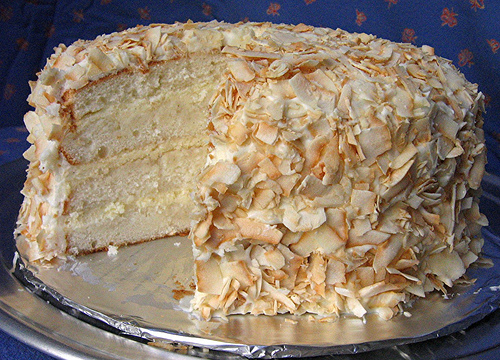 and
mushroom chicken jus for
simplicity and
wholesomeness, and his pan-seared red snapper with Swiss chard,
tahes on crabcake ravioli and spicy tomato consomme for lagniappe.
and
mushroom chicken jus for
simplicity and
wholesomeness, and his pan-seared red snapper with Swiss chard,
tahes on crabcake ravioli and spicy tomato consomme for lagniappe.The wine list may be the best in Charleston.
There are some sumptuous desserts here, but at least one person at your table should go for Carter's now famous coconut layered cake, a magnificent example of Southern abundance, twelve layers five in inches high and ten across, based on his grandmother's recipe. People order it by mail (through the restaurant's website)--I did for my birthday last year--and it's always a hit when displayed and cut into. It's also absolutely delicious. Otherwise go for the sour cream fruit tart or the banana panna cotta with milk chocolate ganache vanilla wafers--a Southern guilty pleasure--and Tia Maria caramel sauce.
The Peninsula Grill certainly gets it fair share of sophisticated travelers to Charleston, but to get a real sense of the genteel traditions for dining with the locals, this is where you'll find it done up with style.
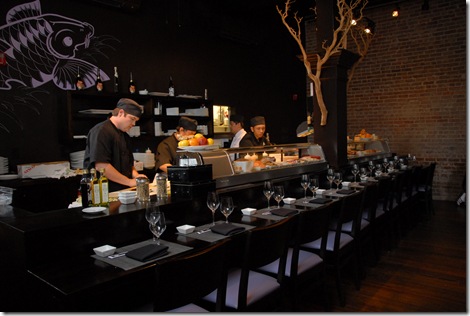 much in the modern
style--no pale wood walls
and counters, this is a terrific design with tall ceilings, great bar
and counter, brick walls and Asian artwork. Chef Sean Park's
handiwork is as impressive as ever, as a lunch proved one spring day,
which consisted of toro
tartare with osietra caviar, Fuji apple, Asian
pear and sudachi mint;
seared Wagyu tataki with
sweet potato puree---a
wonderful match-up--microgreens for texture, soy demi-glace and a
splash of truffle oil; and a grand array of sushi, from uni to toro,
from nigiri to avocado roll,
and for dessert, yuzu pot au crème and
mocha ice cream, which didn't entirely convince me that Asian chefs
have a real grasp on desserts.
much in the modern
style--no pale wood walls
and counters, this is a terrific design with tall ceilings, great bar
and counter, brick walls and Asian artwork. Chef Sean Park's
handiwork is as impressive as ever, as a lunch proved one spring day,
which consisted of toro
tartare with osietra caviar, Fuji apple, Asian
pear and sudachi mint;
seared Wagyu tataki with
sweet potato puree---a
wonderful match-up--microgreens for texture, soy demi-glace and a
splash of truffle oil; and a grand array of sushi, from uni to toro,
from nigiri to avocado roll,
and for dessert, yuzu pot au crème and
mocha ice cream, which didn't entirely convince me that Asian chefs
have a real grasp on desserts. Appetizers run $4-$18, with sushi and sashimi variations $11-$19 (combinations $35-$100).
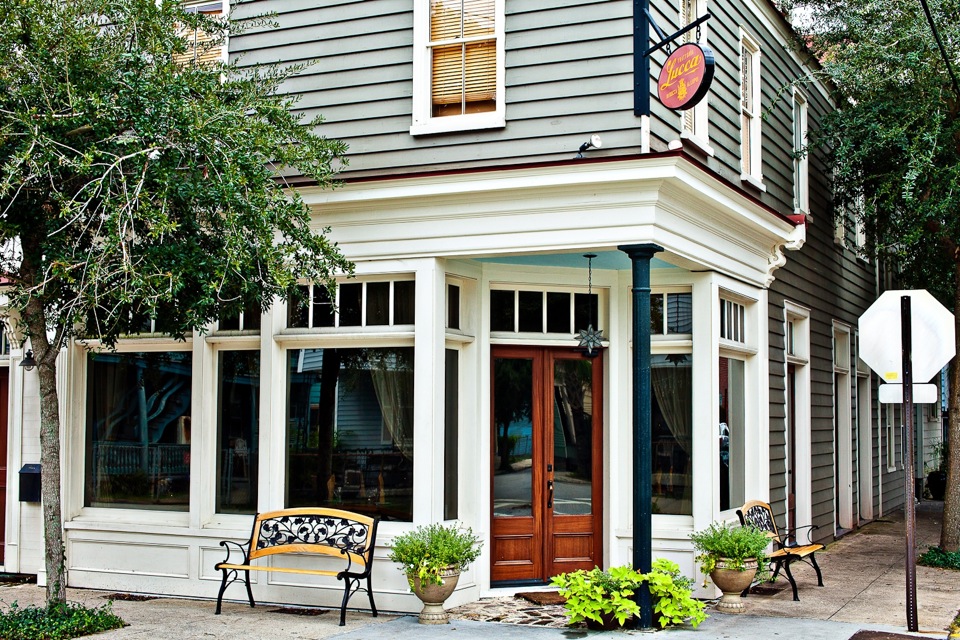 the
kind of modern Italian food--with a big nod
towards Tuscany--in tiny room (it can and will get very loud) that's
become very much a local favorite, away from the center of town.
the
kind of modern Italian food--with a big nod
towards Tuscany--in tiny room (it can and will get very loud) that's
become very much a local favorite, away from the center of town.I was privileged enough to have Vedrinksi throw a book-signing party for me at Lucca, a festive night when he served a lovely, briny crudo of Nantucket Bay scallops with spring vegetables, followed by tuffoli alla Caruso pasta, with chicken livers, then a very richly flavorful deckle of beef, which he grilled and lavished with Gorgonzola cheese and a Vidalia onion sweet fondue and a little arugula with a squirt of lemon. For dessert he went commendably simple--local goat's milk rice pudding with amaretti brûlée, all of this accompanied by excellent chosen wines.
Vedrinski (right) was born in Ohio,
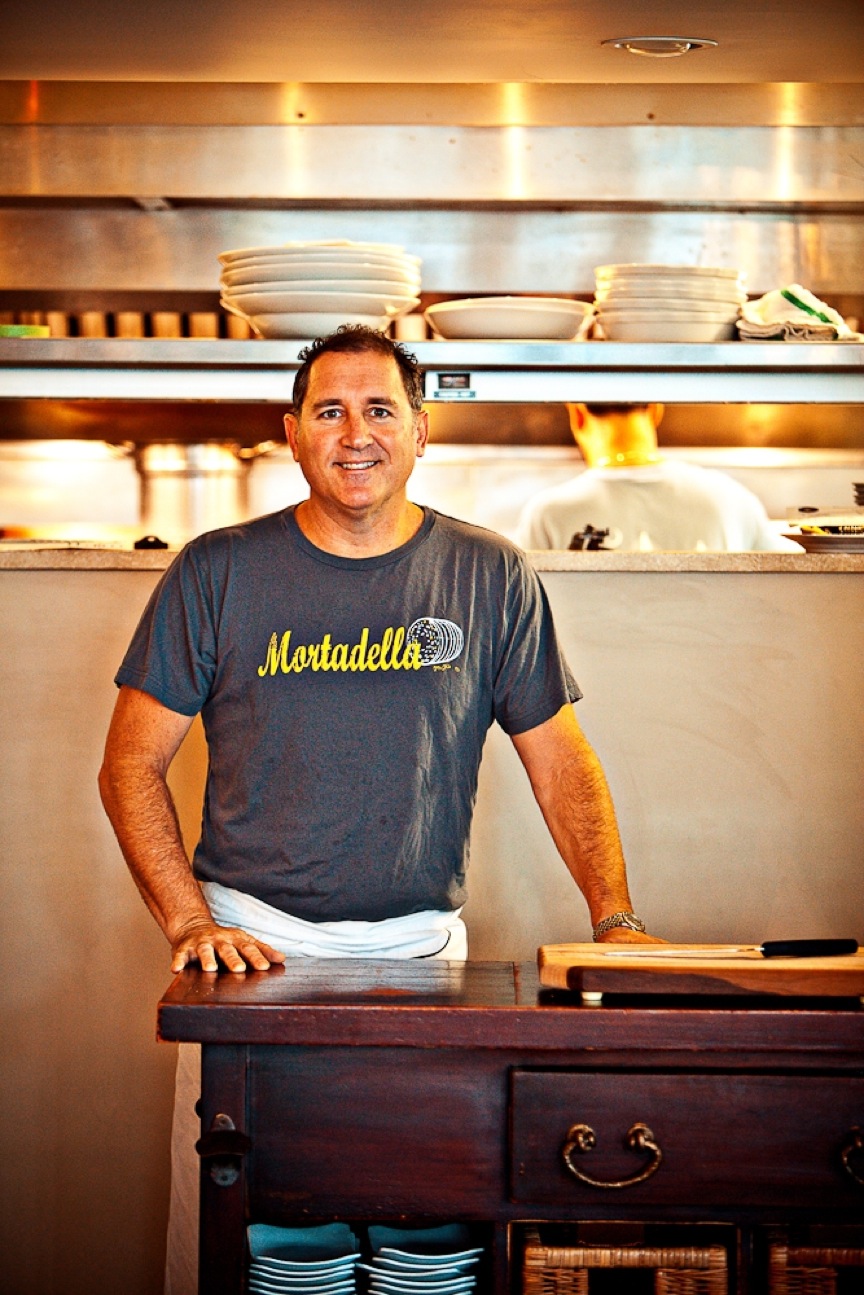 with an Italian grandma who taught him to cook
and do
so with respect. He became a chef at Opus in Atlanta and later at
the posh Woodlands Inn & Resort in Summervile, SC, where he did a
very high-end, sophisticated style of cuisine before opening his own
Italian restaurant on Daniel Island outside of Charleston, which I
named one of Esquire's Best
New Restaurants of 2004. I lost track of
him for a bit, but in 2008 he opened Lucca to great local applause.
Next time I'm in town I will order from a menu whose every dish appeals
to my taste in authentic Italian food.
with an Italian grandma who taught him to cook
and do
so with respect. He became a chef at Opus in Atlanta and later at
the posh Woodlands Inn & Resort in Summervile, SC, where he did a
very high-end, sophisticated style of cuisine before opening his own
Italian restaurant on Daniel Island outside of Charleston, which I
named one of Esquire's Best
New Restaurants of 2004. I lost track of
him for a bit, but in 2008 he opened Lucca to great local applause.
Next time I'm in town I will order from a menu whose every dish appeals
to my taste in authentic Italian food. Antipasti range from $9-$20, pastas (full portions) $19-$28, main courses $21-$27.
 plenty of flair. You
can go for lunch or dinner and eat yourself silly, but I particularly
love breakfast--always jammed--when you can start off with a true
country breakfast of eggs, grits, sausage or bacon, or luscious
buttermilk pancakes. But if you're man or woman enough for it,
order the "Big Nasty Biscuit," with fried chicken breast, Cheddar
cheese and sausage gravy--it is, in a cliché, awesome!
plenty of flair. You
can go for lunch or dinner and eat yourself silly, but I particularly
love breakfast--always jammed--when you can start off with a true
country breakfast of eggs, grits, sausage or bacon, or luscious
buttermilk pancakes. But if you're man or woman enough for it,
order the "Big Nasty Biscuit," with fried chicken breast, Cheddar
cheese and sausage gravy--it is, in a cliché, awesome!For lunch and dinner the specialties here include Southern fried chicken with country ham gravy; shrimp and grits with scallions and bacon; and good old country captain, a chicken breast in a tomato-curry sauce with toasted almonds and currants over jasmine rice. They also do a true purloo rice casserole with sausage, ham, shrimp and fried chicken.
And say hello to Bob and Nunally. You can bet on their being there.
Dinner appetizers runs $3.95-$7.95, main courses $8.95-$16.95.
A
few remarks
on the sad state of barbecue in Charleston,
where you'd think  you'd
fine
some
of
the very best in the South, not
least because of the city's large black population. I
keep
asking
where I can find good Carolina barbecue, and I'm met with a
very sad, wagging head. It doesn't exist. Maybe if you drive many
miles away, to Duke's in Orangeburg, or Sheeley's in Leesville, you'll
find it, but not in Charleston. Don't even think of going to
Sticky Fingers, one of a chain of 17 across the South, and I wouldn't
recommend the 'cue at Pink Pig Bar & Q by Jim 'n Nick's, on King
Street, which has a raffish-looking bar (right) but the food and service is
way below the best in the South, with really dreary pulled pork and
ribs
without much smoke in them. I hope I've been misinformed, but if
anyone knows any good barbecue in Charleston, I'd sure would like to
know
about it.
you'd
fine
some
of
the very best in the South, not
least because of the city's large black population. I
keep
asking
where I can find good Carolina barbecue, and I'm met with a
very sad, wagging head. It doesn't exist. Maybe if you drive many
miles away, to Duke's in Orangeburg, or Sheeley's in Leesville, you'll
find it, but not in Charleston. Don't even think of going to
Sticky Fingers, one of a chain of 17 across the South, and I wouldn't
recommend the 'cue at Pink Pig Bar & Q by Jim 'n Nick's, on King
Street, which has a raffish-looking bar (right) but the food and service is
way below the best in the South, with really dreary pulled pork and
ribs
without much smoke in them. I hope I've been misinformed, but if
anyone knows any good barbecue in Charleston, I'd sure would like to
know
about it.
NEW
YORK
CORNER
MORNINGSIDE
HEIGHTS BY DAY AND NIGHT
By Francesca
Crozier-Fitgerald

For the past five years, I’ve
lived on the Upper
West Side in the well-landscaped, safe, student-populated neighborhood
between
midtown and Harlem known as Morningside Heights. While my first
priority during
this time was to attend class and meet deadlines at Columbia
University, my
friends and I spent our free time exploring the area’s wide variety of
restaurants, live entertainment, and reasonably priced happy hours.
Luckily,
most venues have compassion for their student clientele living on
slender
student budgets. Even though of us head downtown to find a livelier
scene, there
is plenty going on within my ten-block radius for anyone to be satiated, active, and entertained.
To get out of your apartment and off the crowded
streets, there are three expansive, welcoming parks in Morningside
Heights.
Since I first moved to the area, Park Security Services and Columbia
University
Security have increased their patrolling staff in these parks, making
them safe
in daytime and off-hours. The largest and most obvious, Central Park,
can be
entered right at 110th and
Frederick Douglass Circle.
Morningside Park,
found directly behind Columbia University’s campus at 116th
and
Morningside Drive is complete with basketball courts, baseball fields,
and
playgrounds. During exam season, my friends and I would joke that this
park was
placed here as a healthy reminder to Ivy League students that laughter
and
youth truly do exist.
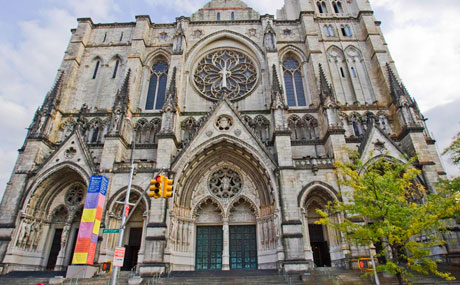 Riverside Park, the
preferred exercise space among students, stretches from 158th
to 72nd,
at which point it feeds into the Hudson River Park along the River. For
centuries, artists, philosophers, and poets alike have been inspired by
the
magnificent landscape this view provides of the Hudson River and the
Palisades
of New
Jersey, as well as the majestic George Washington Bridge. The River’s vastness is a humbling and
necessary natural element for those living in the Big Apple, creating
balance
with the man-made concrete jungle.
Riverside Park, the
preferred exercise space among students, stretches from 158th
to 72nd,
at which point it feeds into the Hudson River Park along the River. For
centuries, artists, philosophers, and poets alike have been inspired by
the
magnificent landscape this view provides of the Hudson River and the
Palisades
of New
Jersey, as well as the majestic George Washington Bridge. The River’s vastness is a humbling and
necessary natural element for those living in the Big Apple, creating
balance
with the man-made concrete jungle.
Morningside Heights
also has several monuments that have managed to bypass the typical
tourist
radar. The Cathedral of St. John the Divine, (left) at 112th
and Amsterdam
Avenue, whose cornerstone was laid in1892, is the world’s largest
Gothic cathedral
and holds regular services for all denominations as well as tours
throughout
its architecturally advanced arches and decorated chapels. The
Cathedral and
its parishioners have withstood two world wars, the Great Depression,
9/11, and
the tragic fire in the north transept in 2001. There has always been
ongoing
construction and many believe it will never truly be finished.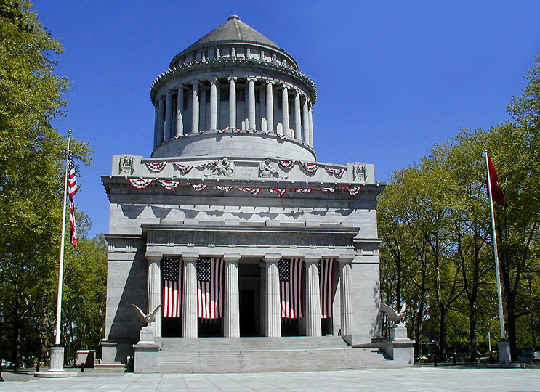 The decision to
continue construction and remain open to the public was so eloquently
justified
to me as a reflection of religious freedom in our world today, as a “a
work in
progress.”
The decision to
continue construction and remain open to the public was so eloquently
justified
to me as a reflection of religious freedom in our world today, as a “a
work in
progress.”
Over
on Riverside Drive and 112th Street, General Ulysses S. Grant’s
Tomb (right) seems
another
well-kept secret of the Upper West Side. Standing as the second largest
mausoleum in the Western Hemisphere and copy of the
tomb
at
Halicarnassus
once
considered
a
Wonder
of
the
World,
this
burial
space
for
our
18th
president and his wife Julia
Boggs Dent Grant demands respectful and sincere reflection from the
moment its
bronze doors comes into view. Architects strategically positioned the
marble
and granite monument to meet Grant’s wishes to overlook the Hudson
River
through laced foliage in Riverside Park.
As
Columbia University’s campus (below)
and
culture
define
a
great
deal
of
the
neighborhood’s
personality,
it
would
be
foolish
to
leave
it off the
list. The
huge wrought iron campus gates on 116th
and Broadway and 116th
and Amsterdam Avenue are open 24 hours a day, monitored by security,
and invite
tourists and students alike to sit on the famous Low Library steps,
visit the
Journalism School, where annual Pulitzer prizes are debated and
announced, see
one of the eight copies of Rodin’s The
Thinker outside Philosophy Hall,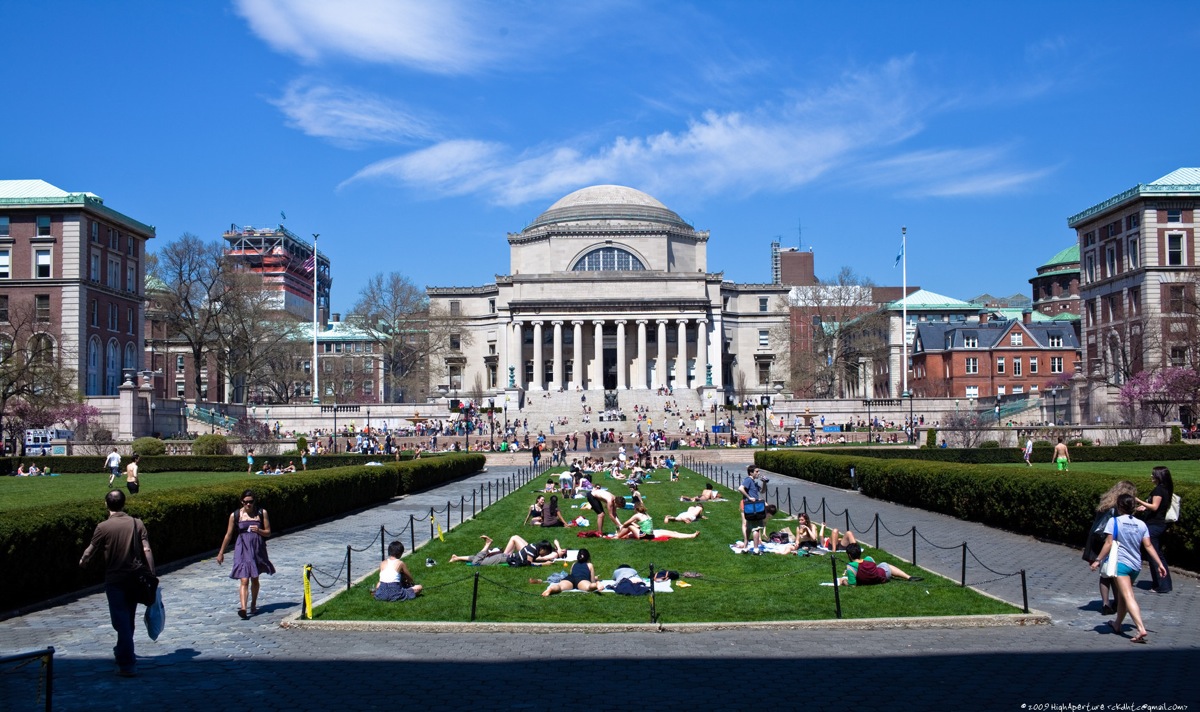 or
peruse the list of performances in
Columbia’s Miller Theater. Concerts feature contemporary musical
performers, composers,
dancers and choreographers at the forefront of their discipline. I have
seen
international composers such as Georg Friedrich Haas, the eclectic John
Zorn,
and twenty-one year old student composer, Ryan Beppel, and was
thoroughly
impressed each time. You leave Miller Theater feeling musically
up-to-date.
or
peruse the list of performances in
Columbia’s Miller Theater. Concerts feature contemporary musical
performers, composers,
dancers and choreographers at the forefront of their discipline. I have
seen
international composers such as Georg Friedrich Haas, the eclectic John
Zorn,
and twenty-one year old student composer, Ryan Beppel, and was
thoroughly
impressed each time. You leave Miller Theater feeling musically
up-to-date.
The
nightlife in Morningside Heights can start as early or as late as you
choose.
Without question, the best happy hour deal in the neighborhood is The Heights Bar and Grill located
between 111th and 112th
on Broadway. The mood is always
lively during The Height’s two separate happy hours, taking place from
4-7 pm
and 11pm until closing. You can get drinks as low as $3 Drafts, frozen
drinks,
and wine by the glass, while noshing on their famous nachos. If you
have never
tried a passion fruit margarita, bartenders at the Heights will be
happy to get
you hooked. While Saturday nights tend to get overcrowded with Columbia
University students, summer months are perfect as they open up the
rooftop bar
and dining space, to offer an optimal view of Morningside Heights.
If
finger food and cheap drinks do not fit your fancy, Vareli
Wine Bar (right) next to
The Heights is a great date spot. Offering
over 20 different wines by the glass and 100 by bottle by certified
sommelier
Richard Bill, it is a classic yet affordable selection for you and
your date.
With large wooden barrel tables lit only by candlelight, Vareli can
boast about
its unique and intimate ambiance.
For
the best burger of Morningside Heights, hit up Mel’s Burger
between 110th and 111th
on
Broadway. It’s a perfectly sized, juicy, quarter pounder patty and does
not
come with french fries, so you need not feel guilty about ordering it.
Fried
zucchini slices are a somewhat healthier substitute for the table.
For
great
drink
and
entertainment
specials
taking
place
in
one
spot
stroll
into
Havana Central (below),
between
114th
and 113th on Broadway. Formerly “The
West End,” where Jack Kerouac used to drink away his
writer’s block,
Havana Central is now an upbeat Cuban club, bar and restaurant.
Offering live Cuban
music on the weekends and daily bar specials, it appeals to students
and
neighborhood who locals
enjoy chatting in this palm tree- decorated atmosphere on the UWS.
Regulars are
especially fond of Havana’s household recipe of fresh, potent Sangria,
and all
six flavors of the $1 Empanada’s during Wednesday’s happy hour.
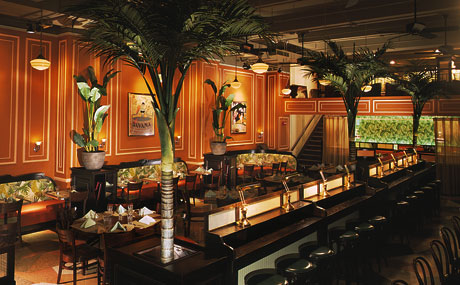 For
the notorious “jumbo” slice of thin crust, cheesy pizza for only $3, Koronet Pizza sits in the middle of 111th
and 110th on Broadway. It can
get noisy, but service is quick and
the pie-size slice can’t be beat for this great price. For
the best Italian meal in the area, I would suggest Pisticci
on 124th between Broadway and
LaSalle. I was
taken here as a freshman for my birthday, when it was still a
relatively secret
spot, and my friends and I were overwhelmed with the unusual pasta
combinations
and meat dishes on the menu. All ingredients are purchased fresh daily
and all
recipes are homemade. Owners Michael and Vivian Forte, originally from
the
southern region of Basilicata, make sure to import items weekly such as
mozzarella and olives that they say, “just cannot be recreated
anywhere!”
For
the notorious “jumbo” slice of thin crust, cheesy pizza for only $3, Koronet Pizza sits in the middle of 111th
and 110th on Broadway. It can
get noisy, but service is quick and
the pie-size slice can’t be beat for this great price. For
the best Italian meal in the area, I would suggest Pisticci
on 124th between Broadway and
LaSalle. I was
taken here as a freshman for my birthday, when it was still a
relatively secret
spot, and my friends and I were overwhelmed with the unusual pasta
combinations
and meat dishes on the menu. All ingredients are purchased fresh daily
and all
recipes are homemade. Owners Michael and Vivian Forte, originally from
the
southern region of Basilicata, make sure to import items weekly such as
mozzarella and olives that they say, “just cannot be recreated
anywhere!”
For
the
best
Soul
Food
in
the
neighborhood,
it’s
probable
that
you
already
know
where
to
go. Sylvia’s Restaurant,
founded in 1962 by Sylvia “Queen of Soul Food” Woods (below), is located at 328 Lenox
in historical Harlem and has been serving authentic food for nearly
sixty
years. Sylvia’s is most famous for the gumbo, candied yams, black-eyed
peas,
fried chicken, barbecued ribs and corn bread recipe. The atmosphere is
always
jovial in the dining room and right next door you can enjoy Sylvia’s
Also
Lounge. Weekly events include Comedy and Poetry Night on
Wednesdays and
Thursdays, Reggae and Latin Night on Friday, and great dancing beats of
“old
and new school classics” on Saturdays. In
recent years Sylvia’s has been joined by a number of
bistros, as well
as the very 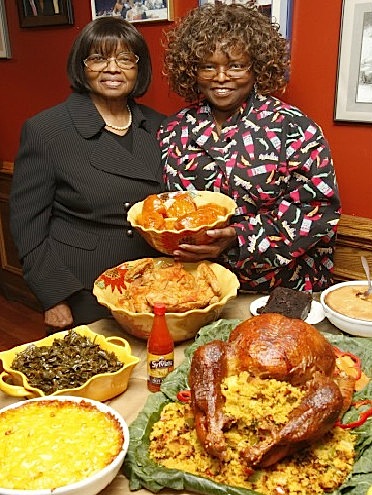 popular
Red Rooster, owned by chef Marcus Samuellsson.
popular
Red Rooster, owned by chef Marcus Samuellsson.
If
you are not looking to drink or eat, but enjoy lounging with a
self-proclaimed
sophisticated crowd, 1020 Bar on 110th
and Amsterdam will fit the grade. Tuesday Trivia Night presents an
intriguing
battle between neighborhood intellectuals and core-curriculum
aficionados from
the nearby University. Patrons can also watch the featured nineties
film on the
big screen hanging on the back wall or the TV’s above the bar. Without
naming each individually, it’s helpful to note that the neighborhood is
stocked
with numerous cafés, delis, and markets for students to run in
and out before
class and many stay open late for the all-nighter library crowd. For
this
reason, the area is regularly patrolled by security and campus safety.
Francesca Crozier-Fitzgerald is a
recent graduate from Columbia University's Graduate School of
Journalism, currently working as a freelance journalist. Her work has
been published in Ambler Gazette's
Ticket to Entertainment, i-Italy Digital Magazine, and The NewYorkWorld. This is her first article for The Virtual
Gourmet.

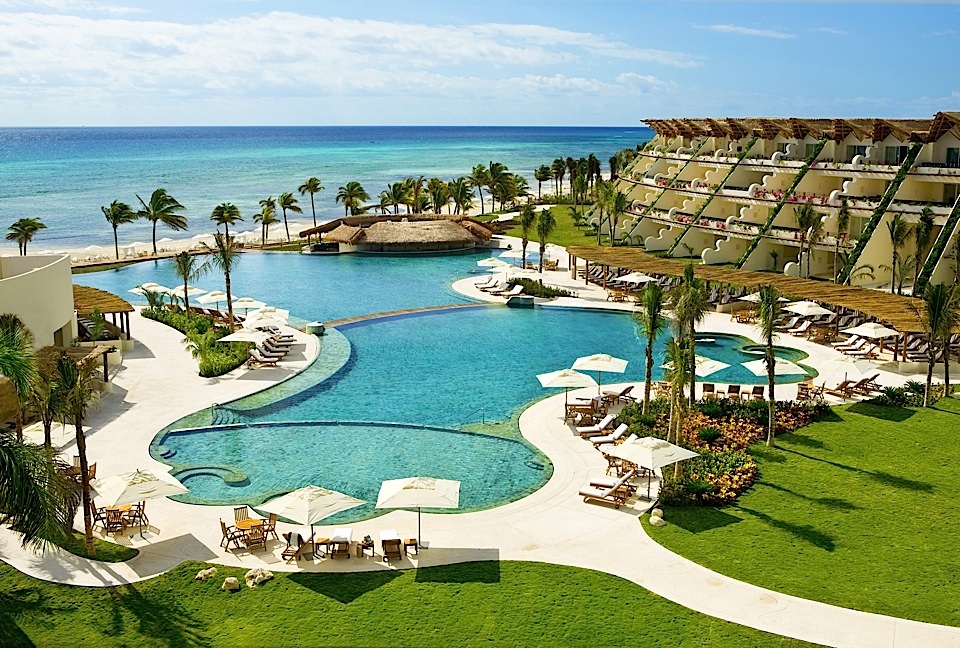
Three weeks ago I headed down to Riviera
Maya
for an end of summer vacation. Mexican tourist destinations are
generally
ghost towns in August and that is fine by me. Hotels run are around
forty
percent occupancy and the beaches and pools are almost empty. Peak
season in
Mexico is during the holidays, especially Christmas and winter break
when
families make up a large majority of the travelers. August may be
slightly
hotter and more humid than other times of the year, but the open space
and
personal service cannot be beat. I would have it no other way.
The beaches go on
for miles and there is almost no one in sight. The bliss of getting
away and actually
feeling secluded from the rest of the word is an idyllic sentiment. In
the
month of August, there is a big influx of European travelers,
specifically from
Italy, who come to Mexico and the Caribbean islands for a tropical
experience
not often, if ever, found in Europe. This is usually the last surge
before
major hotels go into hibernation in preparation for the winter rush.
I stayed at the Grand
Velas, one of Mexico’s finest upscale all-inclusive resorts, and a
180-degree change from the cookie-cutter tourist hotels of Cancun City.
I was surprised
and happy to hear a large majority of hotel guests are Mexican, coming
from all
over the country for vacation. There is a very eclectic group of
visitors on
property who add a wonderful dynamic to the stay. The guests are warm
and the
entire experience is hospitable.
I touched down in
Cancun where the hotel had sent one of their airport shuttle buses to
pick up
my girlfriend 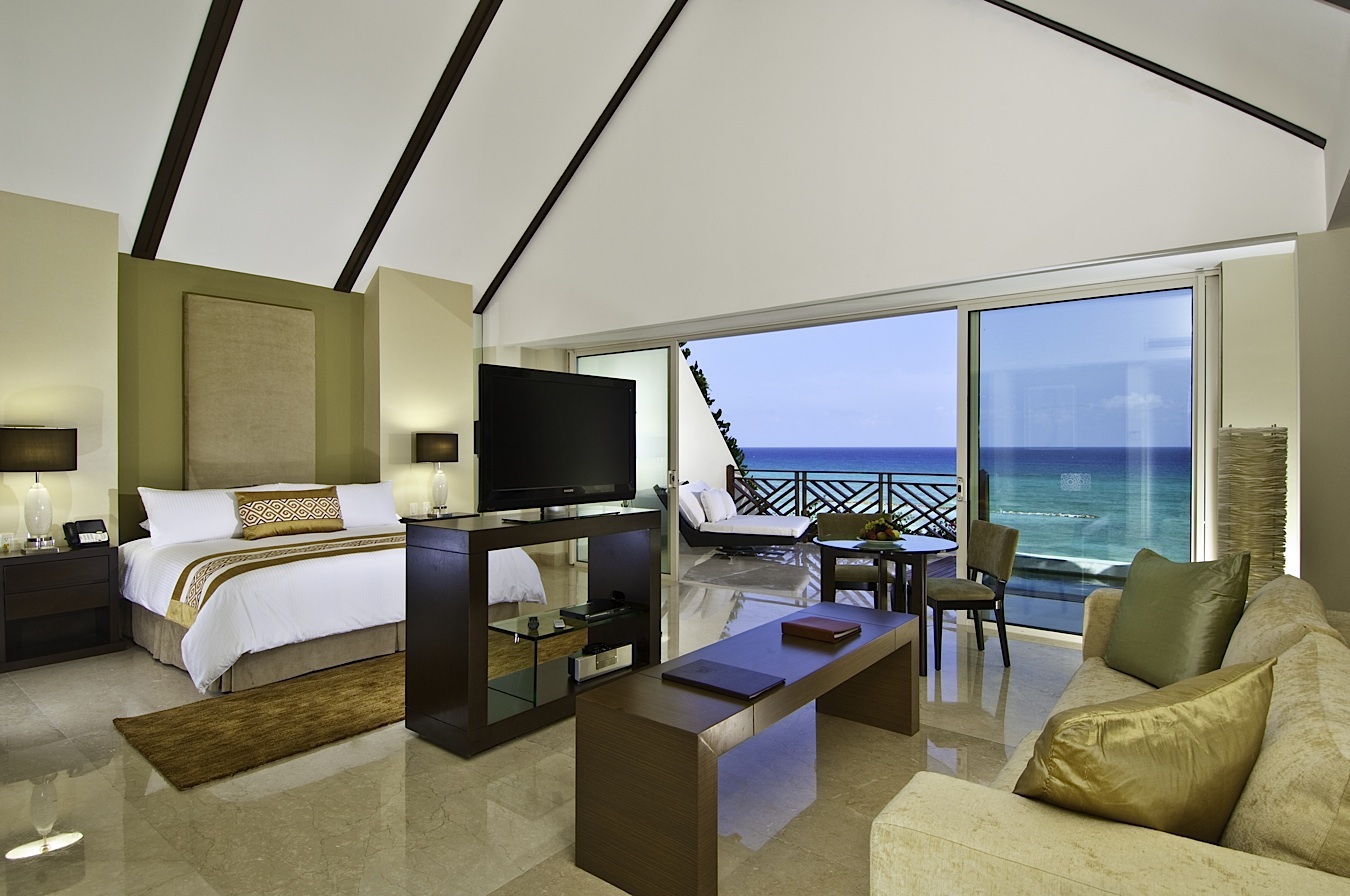 and me, a very pleasant gesture, and much appreciated,
considering the
property is 45 minutes from the airport. Playa del Carmen is just
five minutes' away and Cozumel just across the water; Tulum is 45
minutes away. Once at Grand Velas we were welcomed
with a refreshment and checked in with ease. We were staying in a huge
Grand
Class Suite, 1,377 square feet to be exact. The lay-out was gorgeous,
with a
direct view of the ocean, a concealed terrace dressed with
purple and pink
flowers, a small day pool, a bathroom fit for a king and his
queen, and of
course a mini-bar that re-fills itself every time the room is cleaned
(the mini bar
is part of the initial cost and re-fills are free). Oh, and how could I
forget,
the indoor Jacuzzi? The design is magnificent and is clearly intended
for
guests on a romantic retreat.
and me, a very pleasant gesture, and much appreciated,
considering the
property is 45 minutes from the airport. Playa del Carmen is just
five minutes' away and Cozumel just across the water; Tulum is 45
minutes away. Once at Grand Velas we were welcomed
with a refreshment and checked in with ease. We were staying in a huge
Grand
Class Suite, 1,377 square feet to be exact. The lay-out was gorgeous,
with a
direct view of the ocean, a concealed terrace dressed with
purple and pink
flowers, a small day pool, a bathroom fit for a king and his
queen, and of
course a mini-bar that re-fills itself every time the room is cleaned
(the mini bar
is part of the initial cost and re-fills are free). Oh, and how could I
forget,
the indoor Jacuzzi? The design is magnificent and is clearly intended
for
guests on a romantic retreat.
Upon entering the
massive suite your eyes are immediately drawn to a grand view of the
ocean that stretches calmly just a few hundred feet away while the
bright sun glistens off the
water and fills the white room with light. I was immediately dragged
towards
the terrace where I leaned over the railing and looked out into the
horizon
while inhaling in a deep breath of the sea salt-filled air. Back inside
the
room I took a lay on my king size bed and smiled, knowing my vacation
had
officially begun. I opened the mini-bar and cracked open a can of cold,
crisp
Pacifico and sat outside for a while unwinding, following the shutting
down of my
Blackberry and locking it away in the safe.
The resort as a whole
is one of the most beautiful I’ve seen in Mexico and offers every
amenity one
could wish for. I spent most of my days relaxing by the giant infinity
pool,
occasionally hopping in to cool off and take a leisure stroll to the
swim-up bar
for another Pacifico and sporadically a shot of tequila, always forced
upon me
our generous and encouraging bartender.
Other days we lounged
on the beach where we received personal drink and food service, part of
the
all-inclusive package. So, order as you please because you have already
paid
for it. All liquors are top shelf and there are no boundaries with what
you can
and cannot order.
In terms of food, the
in-room dining was
surprisingly disappointing and needs much
improvement. Breakfast items are all good but when it comes to lunch or
late night snacks do
not expect something great, you are much better off dining in one of
the
hotels eight restaurants.
For breakfast and
lunch Azul (below) is open
with giant windows that stare out onto the beach. They
prepare a terrific buffet every day with great selections but it grew
tiresome
considering we ate there for breakfast and lunch almost every day,
simply
because it was the only option for those two meals besides in-room
dining.
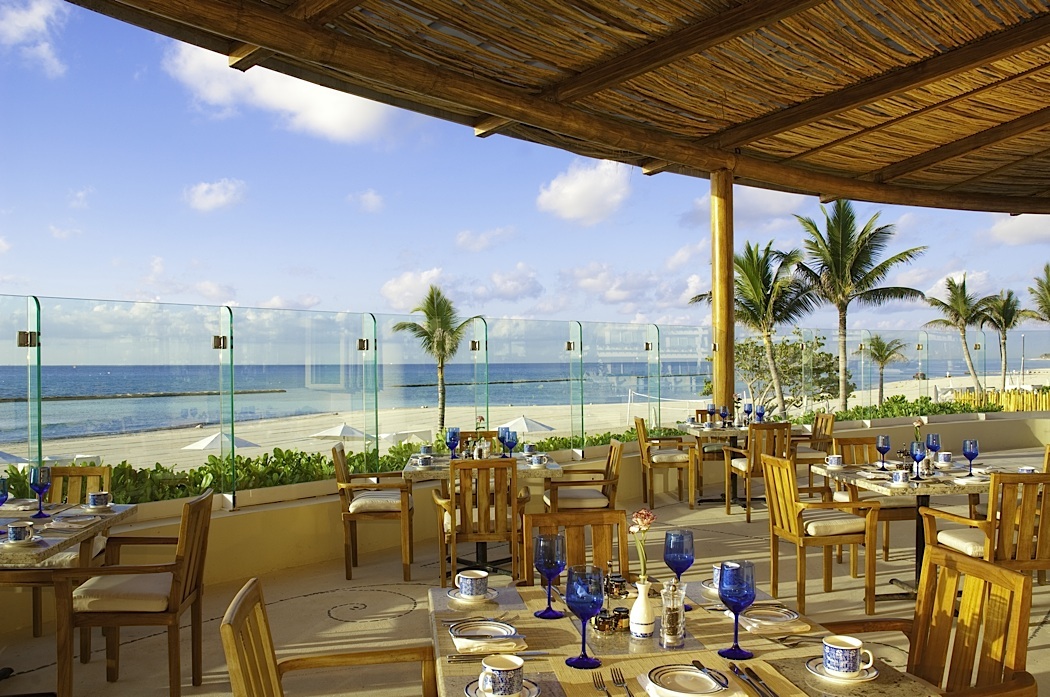 I dined at three other
restaurants during my stay, Sen Lin, Frida and Cocina. All three
restaurants
offer an à la carte menu and/or a chef’s tasting menu paired
with wine. Sen Lin
is the resort’s signature Asian inspired restaurant; Frida is chic
Mexican; and
Cocina is Spanish. There are also French, Italian and Mediterranean
restaurants
on property, so it will be difficult to grow bored. All the restaurants
have
attractive spaces, most very large in size, all with high ceilings and
elegant
décors. The service staff is as
amiable
as one would hope for and they are always within a stones throw to
offer you
another drink. Sen Lin even offers a tableside sake bar
with flavored sakes,
the best was unexpectedly the peanut butter sake. Frida too, offers a
tableside
bar stocked with multiple tequilas with freshly made featured
margaritas.
I dined at three other
restaurants during my stay, Sen Lin, Frida and Cocina. All three
restaurants
offer an à la carte menu and/or a chef’s tasting menu paired
with wine. Sen Lin
is the resort’s signature Asian inspired restaurant; Frida is chic
Mexican; and
Cocina is Spanish. There are also French, Italian and Mediterranean
restaurants
on property, so it will be difficult to grow bored. All the restaurants
have
attractive spaces, most very large in size, all with high ceilings and
elegant
décors. The service staff is as
amiable
as one would hope for and they are always within a stones throw to
offer you
another drink. Sen Lin even offers a tableside sake bar
with flavored sakes,
the best was unexpectedly the peanut butter sake. Frida too, offers a
tableside
bar stocked with multiple tequilas with freshly made featured
margaritas.
The
food
throughout
all
three
restaurants
was
good
at
best.
The common trend
found
in all the restaurants was frou-frou food with little to no balance and
a lack
of fine execution. Take my advice and order off the menu, not the
lengthy tasting menus. Chefs typically reach
beyond their skill level when they put together fancy tasting menus
like the
ones presented during my stay. This is not to say I didn’t have a fine
meal at
each and every restaurant. Notable dishes inlcude the duck
carpaccio with hoisin sauce and the coconut tapioca.
As
the
weekend
came
to
an
end,
I
packed
my
bags and took twenty minutes to
savor
the beauty that last morning in paradise by sitting out on my terrace
and
looking out onto the beach. The peacefulness and seclusion was exactly
what I
hoped for and graciously received. Just before saying my goodbyes to my
lovely
suite, I entered my four-digit code into the safe and retrieved my
Blackberry.
It was back to reality and man did I have a lot of unanswered emails,
but at
least I had a great tan.
To
contact
Christopher
Mariani send an email to christopher@johnmariani.com
❖❖❖

WHITE TRASH WEDDINGS NO.
3,455
In DeWitt,
NY, a couple got married with an
Oscar Mayer Wienermobile in the church parking
lot for a memorable photo op shown here.

"Eggplant gave a convincing performance as the Great Late-Summer Vegetable,
first in a sweet caponata bruschetta; soon after as the money ingredient of a
modified panzanella stuffed inside a sweet pepper; and finally melted down
to a fibrous custard with penne, tomatoes and two cheeses -- mozzarella and
provolone -- that bubbled brown and crusty over the surface of a
hearty pasta casserole."--Brett Anderson, "A Mano," Times-Picayune.
Any of John Mariani's books below
may be ordered from amazon.com.
"Eating Italian will never be the same after reading John Mariani's entertaining and savory gastronomical history of the cuisine of Italy and how it won over appetites worldwide. . . . This book is such a tasteful narrative that it will literally make you hungry for Italian food and arouse your appetite for gastronomical history."--Don Oldenburg, USA Today. "Italian restaurants--some good, some
glitzy--far outnumber their French rivals. Many of these
establishments are zestfully described in How Italian Food Conquered
the World, an entertaining and fact-filled chronicle by food-and-wine
correspondent John F. Mariani."--Aram Bakshian Jr., Wall Street
Journal.
"Equal
parts
history,
sociology,
gastronomy,
and
just
plain
fun,
How
Italian
Food
Conquered
the
World
tells
the
captivating
and
delicious
story
of
the
(let's
face
it)
everybody's
favorite
cuisine
with
clarity,
verve
and
more
than
one
surprise."--Colman
Andrews,
editorial
director
of The
Daily Meal.com.
"A
fantastic
and
fascinating read, covering everything from the influence
of Venice's spice trade to the impact of Italian immigrants in
America and the evolution of alta cucina. This book will serve as a
terrific resource to anyone interested in the real story of Italian
food."--Mary Ann Esposito, host of PBS-TV's Ciao Italia.
"John
Mariani
has
written
the
definitive
history
of
how
Italians
won
their
way
into
our
hearts,
minds,
and
stomachs.
It's
a
story
of
pleasure
over
pomp
and
taste
over
technique."--Danny
Meyer,
owner
of
NYC
restaurants
Union
Square
Cafe,
Gotham
Bar
&
Grill,
The
Modern,
and
Maialino.
|
 |
 |
 |
 |
 |
 |
 |
 |
 Everett
Potter's
Travel
Report:
Everett
Potter's
Travel
Report: 
 Eating
Las
Vegas is the new on-line site for Virtual Gourmet
contributor John
A. Curtas., who since 1995 has been commenting on the Las Vegas food
scene and reviewing restaurants for Nevada Public Radio. He is
also
the restaurant critic for KLAS TV, Channel 8 in Las Vegas, and his past
reviews can be accessed at KNPR.org.
Click
on
the
logo
below
to
go
directly
to
his
site.
Eating
Las
Vegas is the new on-line site for Virtual Gourmet
contributor John
A. Curtas., who since 1995 has been commenting on the Las Vegas food
scene and reviewing restaurants for Nevada Public Radio. He is
also
the restaurant critic for KLAS TV, Channel 8 in Las Vegas, and his past
reviews can be accessed at KNPR.org.
Click
on
the
logo
below
to
go
directly
to
his
site.

Tennis Resorts Online: A Critical Guide to the World's Best Tennis Resorts and Tennis Camps, published by ROGER COX, who has spent more than two decades writing about tennis travel, including a 17-year stretch for Tennis magazine. He has also written for Arthur Frommer's Budget Travel, New York Magazine, Travel & Leisure, Esquire, Money, USTA Magazine, Men's Journal, and The Robb Report. He has authored two books-The World's Best Tennis Vacations (Stephen Greene Press/Viking Penguin, 1990) and The Best Places to Stay in the Rockies (Houghton Mifflin, 1992 & 1994), and the Melbourne (Australia) chapter to the Wall Street Journal Business Guide to Cities of the Pacific Rim (Fodor's Travel Guides, 1991).


The Family Travel Forum
- A community for those who
"Have Kids, Still Travel" and want to make family vacations more fun,
less work and better value. FTF's travel and parenting features,
including
reviews of tropical and ski resorts, reunion destinations, attractions,
holiday
weekends, family festivals, cruises, and all kinds of vacation ideas
should be
the first port of call for family vacation planners. http://www.familytravelforum.com/index.html
ALL YOU NEED BEFORE YOU GO


MARIANI'S VIRTUAL GOURMET NEWSLETTER is published weekly. Editor/Publisher: John Mariani.
Contributing Writers: Christopher
Mariani, Robert Mariani,
John A. Curtas, Edward Brivio, Mort
Hochstein, Suzanne Wright, and
Brian Freedman. Contributing
Photographers: Galina Stepanoff-Dargery, Bobby Pirillo. Technical
Advisor:
Gerry McLoughlin.
© copyright John Mariani 2011
